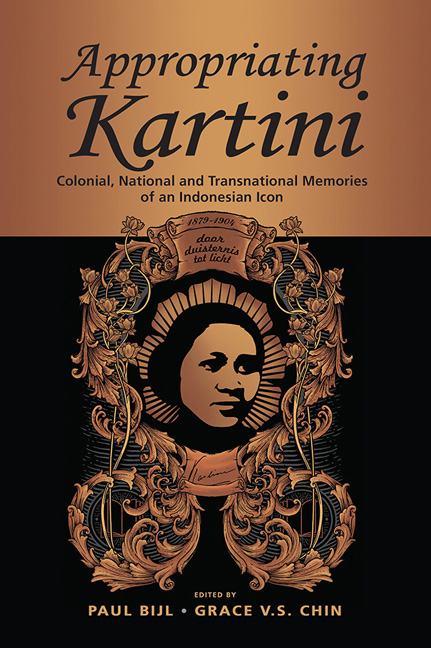Book contents
- Frontmatter
- Contents
- Acknowledgments
- The Contributors
- 1 Introduction
- 2 Crafting Reform: Kartini and the Imperial Imagination, 1898–1911
- 3 Hierarchies of Humanity: Kartini in America and at UNESCO
- 4 Ambivalent Narration: Kartini’s Silence and the Other Woman
- 5 Unpacking a National Heroine: Two Kartinis and Their People 103
- 6 Call me Kartini? Kartini as a Floating Signifier in Indonesian History
- 7 Kartini and the Politics of European Multiculturalism
- 8 Afterword
- Index
2 - Crafting Reform: Kartini and the Imperial Imagination, 1898–1911
Published online by Cambridge University Press: 02 April 2020
- Frontmatter
- Contents
- Acknowledgments
- The Contributors
- 1 Introduction
- 2 Crafting Reform: Kartini and the Imperial Imagination, 1898–1911
- 3 Hierarchies of Humanity: Kartini in America and at UNESCO
- 4 Ambivalent Narration: Kartini’s Silence and the Other Woman
- 5 Unpacking a National Heroine: Two Kartinis and Their People 103
- 6 Call me Kartini? Kartini as a Floating Signifier in Indonesian History
- 7 Kartini and the Politics of European Multiculturalism
- 8 Afterword
- Index
Summary
In the decade before the 1911 publication of a selection of her letters unleashed a century of Kartini image-making, there was a “real” Kartini. A few Dutch men and women maintained a correspondence with her; even fewer had met her in person. And even while this “historical Kartini” was writing long private letters projecting images of herself as a “modern girl”, she was already being imagined by others in the colonial capital and abroad. Her name was beginning to circulate in contemporary media in the Netherlands and its East Indies colony to conjure up a new vision of an imperial mission.
In exploring the ways in which Kartini was variously imagined by Europeans in the few years of her adult public life, this Chapter reads back from the extant correspondence and archival record to examine the discursive contexts that first framed the now century-old image of Kartini.
It focuses on elucidating the contemporary (in Kartini's lifetime) Dutch “cultural imaginary” in terms of the ways in which, it is here argued, an awareness of Kartini was being processed, as well as the ways in which Kartini attempted to present herself.
The notion of a “cultural imaginary”, Dawson (1994) argues, is a useful way of giving recognition to the
fluid imaginative connection between patterns of linked associations [that] can be traced across cultural representations both in textual form and as these have been institutionalised into the practical arrangements that govern activities and social relations within the social world. (Dawson 1994, p. 50)
In brief, the concept alerts us to the importance of taking account of the variety of intertwined influences and cultural institutions that need to be adduced in constructing historical explanations. Here, it suggests that any attempt to unravel the contemporary Dutch reception of “the idea of Kartini” needs to be located in recognition of the complex set of interrelated politico-cultural perceptions, practices and policies present at a particular moment in Dutch cultural, political, social and imperial history. In this, the Chapter argues, the contemporary “imagined Kartini” performed a highly pertinent function. Her “discovery” fed into a range of interrelated discourses and sensibilities that implicated new dimensions in the Netherlands’ imperialist project. For their advocates, seeking political and popular support in both metropolitan and colonial circuits of influence, Kartini provided a useful emblem.
- Type
- Chapter
- Information
- Appropriating KartiniColonial, National and Transnational Memories of an Indonesian Icon, pp. 17 - 45Publisher: ISEAS–Yusof Ishak InstitutePrint publication year: 2020

